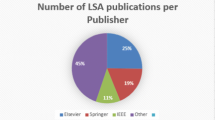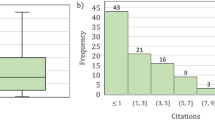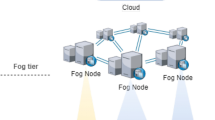Abstract
Interference mitigation has been identified as a key challenge for emerging cellular technologies based on Orthogonal Frequency Division Multiple Access, such as Long Term Evolution. In this context, static intercell interference coordination including Fractional Frequency Reuse (FFR) have been adopted by mobile operators as a good alternative to improve the quality of service at cell edges. Nevertheless, recent results made evident the need for additional research efforts as default FFR configurations only offer tradeoffs in which spectral efficiency is severely penalized. Moreover, the performance of such baseline designs has been showed to be poor in realistic cellular deployments featuring irregular cell patterns. This paper solves this problematic by introducing a novel multiobjective optimization framework based on evolutionary algorithms that jointly takes into account system capacity, cell edge performance, and energy consumption. With respect to important reference schemes, the proposed algorithm succeeds in finding FFR configurations achieving gains between 10 and 40 % in terms of system capacity while simultaneously improving cell edge performance up to 70 %.















Similar content being viewed by others
Notes
Baseline designs refer to settings in which the operational parameters of FFR (\(S_{\text {TH}}, \alpha \) and \(\beta \)) are uniformly applied to all cells of the network.
The definition and evaluation of the objective functions \(f_{1}\), \(f_{2}\), and \(f_{3}\) is presented in Subsect. 5.4.
The search space was obtained after an initial trial and error procedure required to localize the region of interest, i.e., \(K\times \beta \times S_{\text {TH}_{\text {dB}}}\) = \(\{3,4\}\times \{0.300,0.325,0.350,\cdots ,0.500\}\times \{-4,-3,\cdots ,5\}\).
Note that 2D profiles are generated by projecting the Pareto Front onto the \(f_1\)-\(f_2\), \(f_1\)-\(f_3\), and \(f_2\)-\(f_3\) planes. They are an alternative representation providing better insights about the tradeoff between each pair of objective functions.
References
Ali, S., & Leung, V. (2008). Dynamic frequency allocation in fractional frequency reused OFDMA networks. In IEEE Global Telecommunications Conference Workshops (GLOBECOM 2008), (pp. 824–829). doi:10.1109/GLOCOMW.2008.ECP.82.
Bhat, P., Nagata, S., Campoy, L., Berberana, I., Derham, T., Liu, G., et al. (2012). LTE-Advanced: an operator perspective. IEEE Communications Magazine, 50(2), 104–114.
Blum, C., & Roli, A. (2003). ACM Computing Surveys. Metaheuristics in combinatorial optimization: Overview and conceptual comparison, 35(3), 268–368. doi:10.1145/937503.937505.
del Castillo, J., Santos, M., & Villaln, J. (2013). Evaluation of OFDMA resource allocation algorithms in broadband wireless access networks. Telecommunication Systems, 52(4), 2721–2732. doi:10.1007/s11235-011-9598-x.
Chang, R., Tao, Z., Zhang, J., & Kuo, C.C. (2009): A graph approach to dynamic fractional frequency reuse (FFR) in multi-cell OFDMA networks. In IEEE International Conference on Communications (ICC 2009), (pp. 1–6). doi:10.1109/ICC.2009.5198612.
Chen, L., & Yuan, D. (2010): Generalizing FFR by flexible sub-band allocation in OFDMA networks with irregular cell layout. In Wireless Communications and Networking Conference Workshops (WCNCW), 2010 IEEE (pp. 1–5).
Coello, C. A., Lamont, G. B., & Van Veldhuizen, D. A. (2007). Evolutionary algorithms for solving multi-objective problems (2nd ed.). Springer: Genetic and Evolutionary Computation Series.
Correia, L., Zeller, D., Blume, O., Ferling, D., Jading, Y., Gódor, I., et al. (2010). Challenges and enabling technologies for energy aware mobile radio networks. IEEE Communications Magazine, 48(11), 66–72.
Deb, K., Pratap, A., Agarwal, S., & Meyarivan, T. (2002). A fast and elitist multiobjective genetic algorithm: NSGA-II. Transactions on Evolutionary Computation, 6(2), 182–187.
Fleischer, M. (2003). The measure of Pareto optima applications to multi-objective metaheuristics. In Evolutionary Multi-Criterion Optimization, pp. 519–533. Springer, Berlin Heidelberg.
Fraimis, I., Papoutsis, V., & Kotsopoulos, S. (2010). A decentralized subchannel allocation scheme with inter-cell interference coordination (ICIC) for multi-cell OFDMA systems. In IEEE Global Telecommunications Conference (GLOBECOM 2010) (pp. 1–5) doi:10.1109/GLOCOM.2010.5683970.
Gale, D. (2007). Linear programming and The Simplex Method. Notices of the AMS, 54(3), 364–369.
Gill, P. E., & Wong, E. (2010). Sequential quadratic programming methods. Tech. Rep. NA-10-03, Department of Mathematics. San Diego, La Jolla, CA: University of California.
Global mobile Suppliers Association (GSA): Status of the LTE ecosystem (2012).
González G, D., García-Lozano, M., Ruiz, S., & Olmos, J. (2011). On the performance of static inter-cell interference coordination in realistic cellular layouts. Lectures of the Institute for Computer Sciences. Social Informatics and Telecommunications Engineering (LNICST), 68, 163–176.
González G, D., García-Lozano, M., Ruiz, S., & Olmos, J. (2014). On the need for dynamic downlink intercell interference coordination for realistic long term evolution deployments. Wireless Communications and Mobile Computing, 14(4), 409–434. doi:10.1002/wcm.2191.
González G, D., García-Lozano, M., Ruiz Boque, S., & Olmos, J. (2012). An analytical view of static intercell interference coordination techniques in ofdma networks. In: 2012 IEEE Wireless Communications and Networking Conference Workshops (WCNCW, (pp. 300–305).
Haddad, A., Doumith, E., & Gagnaire, M. (2013). A fast and accurate meta-heuristic for failure localization based on the monitoring trail concept. Telecommunication Systems, 52(2), 813–824. doi:10.1007/s11235-011-9579-0.
Hassan, N., & Assaad, M. (2009). Optimal fractional frequency reuse (FFR) and resource allocation in multiuser OFDMA system. In International Conference on Information and Communication Technologies (ICICT ’09) (pp. 88–92) doi:10.1109/ICICT.2009.5267207.
Huawei: R1–103458: Analysis on the eICIC schemes for the control channels in HetNet. 3GPP (2010). TSG RAN WG1 Meeting #61bis: Dresden, Germany.
Irmer, R., Droste, H., Marsch, P., Grieger, M., Fettweis, G., Brueck, S., et al. (2011). Coordinated multipoint: Concepts, performance, and field trial results. IEEE Communications Magazine, 49(2), 102–111.
Khemiri, S., Boussetta, K., & Pujolle, G. (2012). A tabu search heuristic for bandwidth allocation in fixed wimax. Telecommunication Systems, 51(1), 81–91. doi:10.1007/s11235-010-9417-9.
Lakshminarasimman, N., Baskar, S., Alphones, A., & Willjuice, I. M. (2011). Evolutionary multiobjective optimization of cellular base station locations using modified NSGA-II. Wireless Networks, 17(3), 597–609. doi:10.1007/s11276-010-0299-2.
Liao, M. Y., Tsai, C. W., Yang, C. S., Chiang, M. C., & Lai, C. F. (2013). Energy efficiency based on high performance particle swarm optimization: a case study. Telecommunication Systems, 52(2), 1293–1304. doi:10.1007/s11235-011-9641-y.
Mitran, P., Rosenberg, C. (2012). On fractional frequency reuse in imperfect cellular grids. In IEEE Wireless Communications and Networking Conference (WCNC) (pp. 2967–2972) doi:10.1109/WCNC.2012.6214312.
Novlan, T., Ganti, R., Ghosh, A., & Andrews, J. (2011). Analytical evaluation of fractional frequency reuse for ofdma cellular networks. IEEE Transactions on Wireless Communications, 10(12), 4294–4305.
Racz, A., Reider, N., Fodor, G. (2008). On the impact of inter-cell interference in LTE. In IEEE Global Telecommunications Conference (GLOBECOM 2008) (pp. 1–6) doi:10.1109/GLOCOM.2008.ECP.1038.
Samsung: R1–051341: Flexible fractional frequency reuse approach. 3GPP (2005). TSG RAN WG1 Meeting #43: Seoul, Korea.
Sawaragi, Y., Hirotaka, I., & Tanino, T. (1985). Theory of multiobjective optimization (1st ed.). Orlando: Academic Press, Inc.
Solovay, R. M. (1970). A model of set-theory in which every set of reals is lebesgue measurable. The Annals of Mathematics, 92(1), 1–56.
Spall, J. C. (2003). Introduction to stochastic search and optimization (1st ed.). Hoboken: Wiley-Interscience.
Stolyar, A., Viswanathan, H. (2008). Self-organizing dynamic fractional frequency reuse in OFDMA systems. In 27th IEEE Conference on Computer Communications (INFOCOM 2008), vol. 1 doi:10.1109/INFOCOM.2008.119.
Verdone, R. et al. (2004). MORANS White Paper - Update. Tech. Rep. available as TD(04)062, COST 273, Greece.
Vilfredo Federico Pareto: Cours d‘Economie Politique. ANNALS of the American Academy of Political and Social Science 1897 9 (1896–1897). doi: 10.1177/000271629700900314. l‘Universit de Lausanne.
Wang, Y., Wei, G., & Xiang, W. (2013). Inter-cell interference modeling for cellular network. Telecommunication Systems, 53(1), 99–105. doi:10.1007/s11235-013-9682-5.
Weise, T. (2009). Global optimization algorithms - theory and application, second edn. Self-Published Online available at http://www.it-weise.de/
Xiang, Y., Luo, J., & Hartmann, C. (2007). Inter-cell interference mitigation through flexible resource reuse in OFDMA based communication networks. European Wireless, 2007, 1–7.
Yang, Q., & Ding, S. (2007). Novel algorithm to calculate hypervolume indicator of Pareto approximation set. Advanced Intelligent Computing Theories and Applications, 2, 235–244. doi:10.1007/978-3-540-74282-1_27.
Zitzler, E., Thiele, L. (1998). Multiobjective optimization using evolutionary algorithms - a comparative case study. In: Parallel Problem Solving from Nature V, Springer, p. 292–301
Author information
Authors and Affiliations
Corresponding author
Rights and permissions
About this article
Cite this article
González G., D., García-Lozano, M., Ruiz, S. et al. Multiobjective optimization of fractional frequency reuse for irregular OFDMA macrocellular deployments. Telecommun Syst 61, 659–673 (2016). https://doi.org/10.1007/s11235-015-0060-3
Published:
Issue Date:
DOI: https://doi.org/10.1007/s11235-015-0060-3





